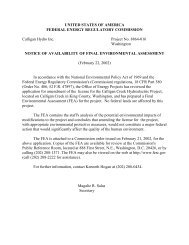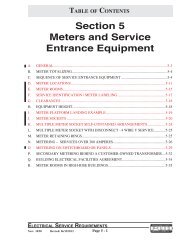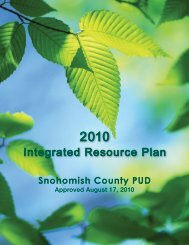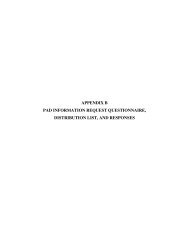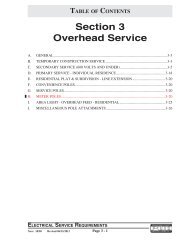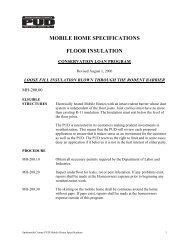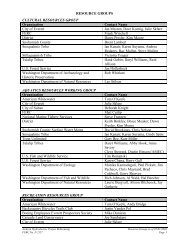Tidal_PAD_V1_Sec4.pdf - Snohomish County PUD
Tidal_PAD_V1_Sec4.pdf - Snohomish County PUD
Tidal_PAD_V1_Sec4.pdf - Snohomish County PUD
Create successful ePaper yourself
Turn your PDF publications into a flip-book with our unique Google optimized e-Paper software.
<strong>Snohomish</strong> <strong>County</strong> <strong>PUD</strong> –Pre-Application Document<br />
4 – Existing Environment<br />
British Columbia to take advantage of the basin’s protected bays and channels (Speich and Wahl<br />
1995; USFWS 1997). During the breeding season, murrelets are concentrated where food and<br />
nearby nesting habitat are abundant, including the Strait of Juan de Fuca, the south shore of Lopez<br />
Island, the southwest shore of Lummi Island, Obstruction and Peavine passes between Orcas and<br />
Blakely islands in the San Juans, Point Wilson, Point Roberts, Cattle Point, Green Point, Tongue<br />
Point, and Dungeness Wildlife Refuge and Spit (Seattle Audubon Society 2007; Speich and Wahl<br />
1995). Areas of winter concentration include Sequim, Discovery and Chuckanut bays; the waters<br />
around the San Juan and Whatcom <strong>County</strong> islands; and, the inland waters east of and including<br />
Admiralty Inlet (Seattle Audubon Society 2007; Speich and Wahl 1995).<br />
Table 4-52. Site-specific description of the presence of the marbled murrelet by project area<br />
Site<br />
Admiralty Inlet<br />
Species Present:<br />
Yes<br />
Spieden Channel<br />
Species Present:<br />
Yes<br />
San Juan Channel<br />
Species Present:<br />
Yes<br />
Guemes Channel<br />
Species Present:<br />
Yes<br />
Deception Pass<br />
Species Present:<br />
Yes<br />
Agate Passage<br />
Species Present:<br />
Yes<br />
Rich Passage<br />
Species Present:<br />
Yes<br />
Marbled Murrelet (Brachyramphus marmoratus) - Status: Threatened<br />
Description<br />
Admiralty Inlet is characterized by several features that make it favorable to the<br />
presence of marbled murrelets. It possesses both under-story and canopy-forming<br />
kelp, elevated current velocities as well as sill-type structures at both entrances which<br />
promote enhanced mixing. It also possesses Pacific herring spawning grounds within<br />
its confines.<br />
Spieden Channel is also characterized by several features that make it favorable to the<br />
presence of marbled murrelets. Like Admiralty Inlet, it possesses both under-story<br />
and canopy-forming kelp, elevated current velocities as well as a narrow-shelf<br />
shoreline of mixed rock substrate. It also possesses Pacific sand lance and smelt<br />
spawning grounds within its confines.<br />
San Juan Channel possesses both under-story and canopy-forming kelp, elevated<br />
current velocities, and a narrow-shelf shoreline with a gravel based substrate. It also<br />
possesses Pacific sand lance and smelt spawning grounds within its confines.<br />
While Guemes Channel does not possess all of the same qualities as the above sites, it<br />
does possess under-story kelp and elevated current velocities. It is also very near the<br />
San Juan and Whatcom <strong>County</strong> islands, which are areas of year round marbled<br />
murrelet concentration.<br />
Deception Pass possesses several features that make it favorable to the presence of<br />
marbled murrelets including both under-story and canopy-forming kelp, elevated<br />
current velocities, and a narrow-shelf shoreline of mixed bedrock, gravel and sand<br />
substrate.<br />
Agate Passage is characterized by several features that also make it favorable to the<br />
presence of marbled murrelets. Like Guemes Channel, it possesses only under-story<br />
kelp, but elevated current velocities and the presence of Pacific herring spawning<br />
grounds within its confines may attract marbled murrelets.<br />
Rich Passage is perhaps the least favorable of all the sites for the presence of marbled<br />
murrelets. Although it does not possess spawning grounds for any of the forage fish<br />
species nor canopy-forming kelp, it does possess under-story kelp and elevated<br />
current velocities as well as benthic substrates of mixed gravel and sand.<br />
Sources: 1982 Survey - Speich and Wahl, 1989; DON, 2006; Evans- Hamilton, Inc., 1987; PSWQA, 1992;<br />
4-144 January 31, 2008




